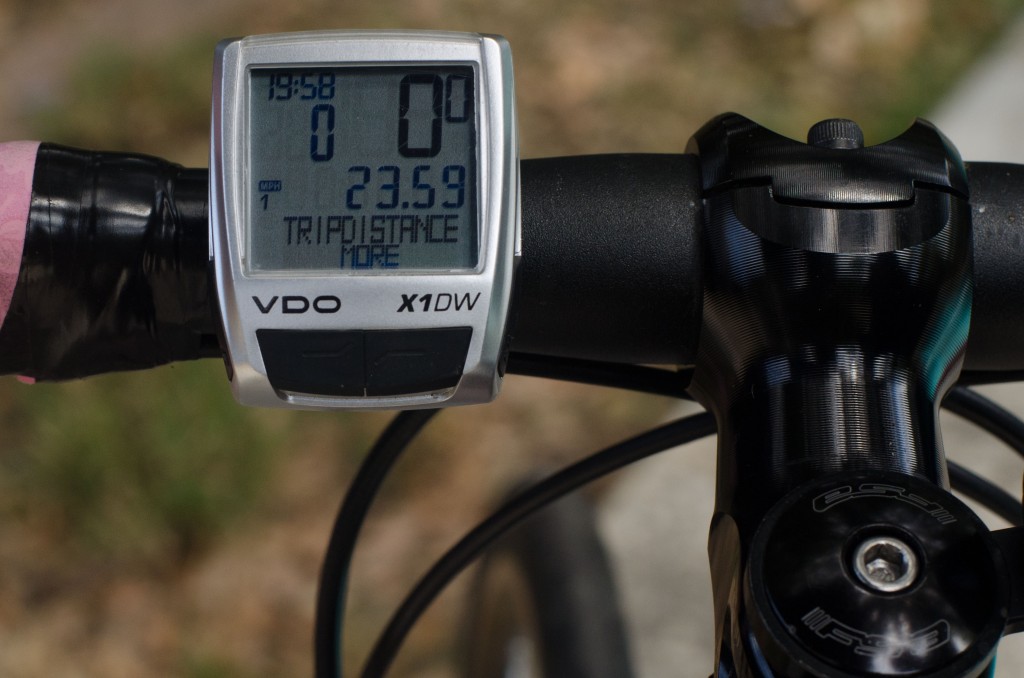![]() VDO is widely known for creating instrumentation used by Mercedes, BMW and Porsche. But even with prior VDO brand experience, two college degrees, and a former BMW mechanic for a husband, installing this cyclocomputer was a challenge. Why? Because each VDO model has different requirements with sensors that must be strategically positioned. In their manual, VDO suggests that the sensors on the X1DW are placed no more than 60 cm from the cyclocomputer. My overall recommendation is this: Save time. Always read the manual!
VDO is widely known for creating instrumentation used by Mercedes, BMW and Porsche. But even with prior VDO brand experience, two college degrees, and a former BMW mechanic for a husband, installing this cyclocomputer was a challenge. Why? Because each VDO model has different requirements with sensors that must be strategically positioned. In their manual, VDO suggests that the sensors on the X1DW are placed no more than 60 cm from the cyclocomputer. My overall recommendation is this: Save time. Always read the manual!
 No more squinting!
No more squinting!
The VDO X1DW display is so large and easy to read,
it’s doesn’t require a lot of extended concentration and will therefore
not distract you from riding safety. This is especially true for those
of us with aging eyes.
On this roughly 3cm x 3cm screen, five sections display:
- time
- current cadence (if installed)
- current speed
- your choice of data (cadence, ride time, average speed, maximum speed)
- description of that choice
By repeatedly tapping the button on the top right, you can rotate through your choice of data, having a ton of information at your fingertips.
Though the X1DW is an entry level cyclocomputer, it’s loaded with functions including optional cadence, average cadence and max cadence. This feature is particularly useful if you are trying to master the spin (keeping your cadence between 80-100 RPM) so as not to traumatize or damage your knees. It has the ability to collect data from two bikes and even combine the mileage for a grand total. You can even program it to remind you to get your bike(s) serviced.
The computer has different functions assigned to four large menu buttons placed in such a way that it’s less likely you will accidentally clear a mode or lose data from a ride.
This is the first wireless computer I’ve had on any bicycle and I was pleased that I didn’t have a bunch of zip ties cluttering up my beautiful ride. The unit easily mounts to the handlebars or stem without special tools. It’s reasonably priced at around $80. However, the VDO X1DW requires 3 CR2032 (3 volt) batteries for the computer, speed transmitter and cadence trasmitter (optional). These batteries don’t seem to last long, so keep extras around the house (if managing your bike data is important to you.) Since the computer itself does most of the work, be sure and change the battery in it first before replacing the others.
The instruction manual states, “When the battery is changed, all settings and the total kilometres cycled are saved.” Unfortunately my computer battery was functional at the time I changed it, yet I did lose all my settings. Incidentally, I ride with 650c wheels and have determined the correct wheel setting at 77.5.
The only issue I had with the VDO X1DW was with the cadence function. It was somewhat unpredictable working only about 75% of the time. After consulting the instructions I moved the cadence sensor from the chain stay to the seat tube so that it too, is positioned 60 cm from the cyclocomputer. Problem solved. I love that instruction manual. It (and the computer) even comes in 7 languages.


Comments are closed.